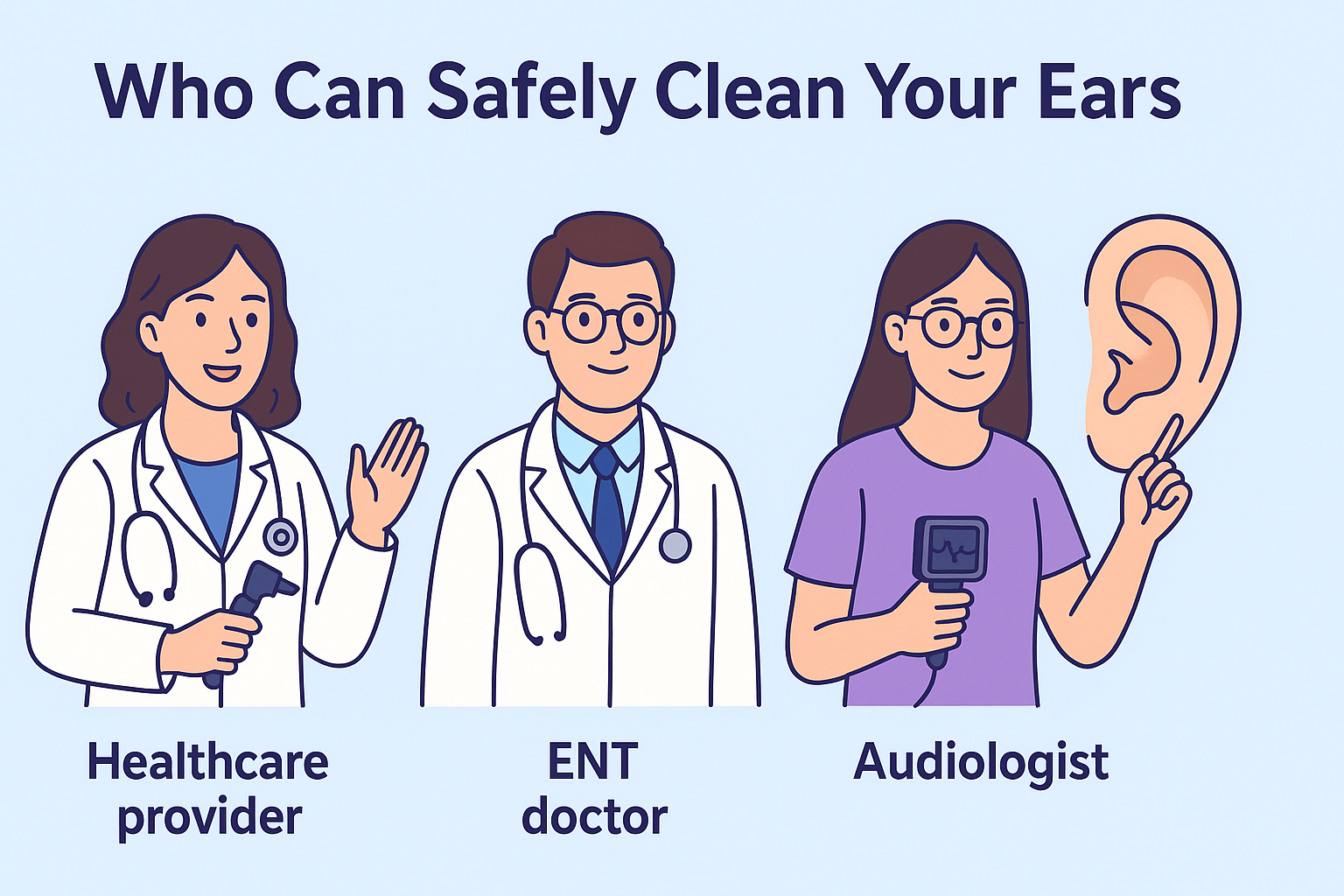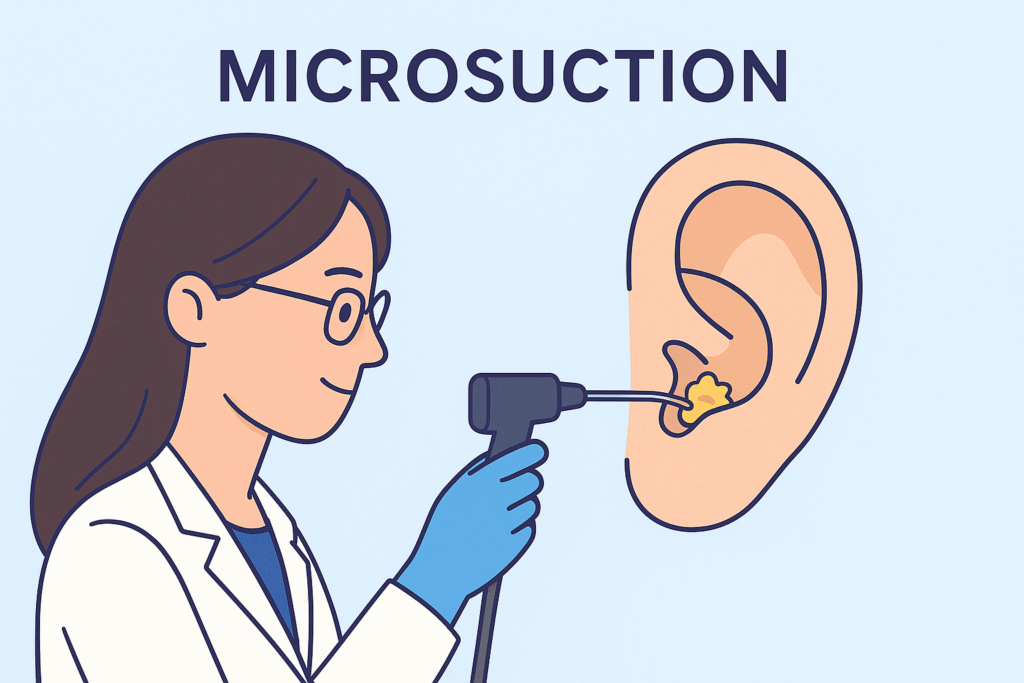Ears are self-cleaning marvels, naturally producing wax that traps dust and debris before ushering it out of the canal. But sometimes, this natural process goes awry. Excess wax buildup can lead to a variety of unpleasant symptoms, including: Muffled hearing, Ringing in the ears (tinnitus), Earache, Dizziness and Cough.
If you’re experiencing any of these issues, it might be time to consider professional ear cleaning.
Why Not Cotton Swabs?
While cotton swabs may seem like a convenient tool for earwax removal, they can actually be counterproductive. The delicate skin lining your ear canal can easily be scratched by a cotton swab, potentially leading to infection.
Furthermore, cotton swabs often push wax deeper into the canal rather than removing it. This can cause a buildup, or impaction, which can be quite uncomfortable and require professional attention.
Who Can Safely Clean Your Ears?
Ever feel like your ears need a deeper clean than what a washcloth can provide? While earwax plays a natural role in ear health, buildup can sometimes lead to discomfort or hearing problems.
In these cases, trusting your ears to qualified healthcare professionals is the safest and most effective way to remove excess earwax. These professionals have the expertise and tools to safely address any blockage and restore your hearing comfort.

Options may include earwax softening drops, irrigation, or microsuction, all performed with a focus on your ear health.
Ear, Nose, and Throat (ENT) Specialist
While earwax typically clears on its own, sometimes excess buildup or impaction can lead to discomfort and require a visit to a specialist.
Ear, Nose, and Throat (ENT) specialists, also known as otolaryngologists, are medical professionals trained to diagnose and treat a wide range of disorders of the ear, nose, and throat.
Beyond simple wax removal, ENTs can identify and address underlying ear conditions, allergies, or sinusitis that might be contributing to excess wax production.
So, if you’re experiencing persistent earaches, muffled hearing, or any concerning ear symptoms, an ENT can provide a comprehensive evaluation and safe, effective treatment.
Audiologist
For earwax removal that goes beyond at-home remedies, consider consulting a licensed audiologist. These healthcare professionals specialize in hearing and balance, and possess the necessary expertise to address earwax buildup.
Audiologists utilize specialized tools and techniques for safe and effective wax removal, often performed alongside a comprehensive hearing evaluation to identify any underlying concerns related to hearing loss.
Primary Care Physician (PCP)
For mild earwax buildup, a visit to your Primary Care Physician (PCP) during a routine checkup might be a convenient option. They can examine your ears and safely remove any blockage if necessary.
This can be a time-saving solution if you’re already scheduled for a checkup, but it’s important to note that PCPs may not be equipped for more complex earwax removal procedures.
Earwax buildup can sometimes be a sign of a deeper issue, so a PCP visit can ensure overall ear health while addressing any immediate concerns.
MinuteClinic
Having bothersome earwax buildup can be frustrating, affecting your hearing and causing discomfort. If you’re looking for a convenient option to get your ears professionally cleaned, MinuteClinic locations inside CVS pharmacies can be a great solution.
Staffed by qualified healthcare providers, MinuteClinic offers quick and professional ear cleaning services. This is particularly helpful for uncomplicated wax buildup, where a healthcare professional can safely remove it and rule out any underlying ear conditions.
Important Note:
Having your ears professionally cleaned can be a safe and effective way to remove excess earwax buildup.
This is especially important if you experience frequent blockages, hearing loss, or discomfort. Before undergoing any earwax removal procedure, it’s crucial to consult a doctor, especially if you have a history of ear infections, a perforated eardrum (rupture in the eardrum), tinnitus (ringing in the ears), or use hearing aids.
What to Expect During Professional Ear Cleaning?
The specific procedure used for earwax removal will depend on the severity of the impaction and the healthcare professional performing it.
Here’s a general overview of what to expect:
Consultation and Examination
Before diving into the wax removal itself, your visit will begin with a conversation with the healthcare professional. They’ll discuss any symptoms you’re experiencing and review your medical history in detail.
This helps them understand your situation completely. Next comes the examination: using a special tool called an otoscope, the professional will gently examine your ear canal for any excess wax buildup.
This assessment allows them to determine the most suitable treatment course for your specific needs.
Wax Removal Techniques
Unlike resorting to potentially risky methods at home, professional ear cleaning utilizes common and effective techniques to ensure safe and thorough earwax removal.
These methods include microsuction, a gentle vacuum procedure that removes wax with precision, and ear irrigation, where warm water is strategically flushed to dislodge buildup.
Microsuction
For many, earwax buildup can be a frustrating issue. While some home remedies exist, healthcare providers often recommend a procedure called microsuction for its precision and safety.

This minimally invasive technique utilizes a gentle suction device to remove earwax under a microscope’s magnification. This allows for the healthcare provider to visualize the ear canal clearly, minimizing the risk of damage to the delicate ear structures.
Because of these advantages, microsuction has become a preferred method for many healthcare providers for removing earwax buildup.
Irrigation
Unlike the common cotton swab method, which can push wax deeper into the ear canal, irrigation utilizes a gentle stream of warm water to flush out any excessive wax buildup.
This technique helps loosen and remove the wax without damaging the delicate ear canal.
Curettage
In certain cases, impacted ear wax may prove too stubborn for even the gentlest over-the-counter remedies. That’s where manual removal with specialized tools comes in.
This procedure, known as curettage, utilizes a tiny, curved instrument to carefully scoop out the blockage from the ear canal. While the idea might sound intrusive, experienced healthcare professionals perform curettage swiftly and with minimal discomfort.
Post-Cleaning Care
While the professional will thoroughly clean your ears during the procedure, post-cleaning care is crucial for optimal healing and preventing future issues. Your doctor will provide specific instructions, but generally, avoid using cotton swabs in your ears as they can push wax deeper into the canal.
Opt for over-the-counter pain relievers if you experience mild discomfort following the procedure. If you have any concerns or persistent pain after a reasonable period, consult your doctor again. Earwax softeners might be recommended for future use to prevent buildup.
Additional Considerations
Cost
Beyond the immediate impact on your well-being, healthcare decisions involve a careful orchestration of various factors. Location can influence wait times and access to specialists, while the complexity of a procedure can significantly affect cost.
Insurance coverage will dictate your out-of-pocket expenses, and selecting the right healthcare provider with the necessary experience for your specific condition is paramount. Don’t forget to consider the cost transparency of the facility and negotiate if possible.
Follow-Up Appointments
While professional ear cleaning by a qualified healthcare provider is generally a safe and effective way to remove bothersome earwax buildup, follow-up appointments might be necessary in some cases.
If your initial cleaning doesn’t fully resolve your lingering symptoms, like muffled hearing or discomfort, it might indicate incomplete wax removal or even underlying ear conditions.
Your provider can help monitor the situation, address any recurring earwax buildup, and determine if over-the-counter ear drops, formulated to soften wax buildup for occasional use, are suitable to prevent future wax impactions.
Remember, practices like avoiding excessive use of headphones and earplugs can also contribute to healthy ears.
Conclusion
While earwax buildup is a natural process, excessive amounts can lead to various symptoms like muffled hearing and discomfort. If you suspect a blockage, it’s important to prioritize consulting a doctor or other qualified healthcare professional.
They can determine the best course of treatment and recommend safe and effective ear cleaning procedures to restore your hearing and comfort.
Frequently asked Question
How often should I get my ears professionally cleaned?
Most people don’t need professional ear cleaning regularly. However, if you experience frequent earwax buildup or have symptoms like muffled hearing or pain, you might need it once in a while. Consulting a doctor is best to determine the frequency you might need.
Is professional ear cleaning painful?
Professional ear cleaning is generally not painful. The techniques used, like microsuction or irrigation, are designed to be gentle and comfortable. However, you might experience some mild discomfort if you have a lot of earwax buildup or very sensitive ear canals.
What are the risks of professional ear cleaning?
When performed by a qualified healthcare professional, the risks of professional ear cleaning are minimal. However, there is a slight chance of ear canal irritation, dizziness, or even damage to the eardrum if not done correctly. This is why attempting earwax removal yourself with cotton swabs or other objects is highly discouraged.
Can I use over-the-counter ear drops to remove earwax?
Yes, there are over-the-counter ear drops that can help soften earwax and make it easier to come out naturally. However, it’s important to choose the right type of drops and follow the instructions carefully. If your symptoms persist after using ear drops, see a doctor for professional cleaning.
Can I use a cotton swab to clean my ears?
No, using cotton swabs to clean your ears is not recommended. Cotton swabs can actually push earwax deeper into the ear canal, causing impaction and potentially damaging the eardrum. It’s best to leave earwax removal to a healthcare professional.
What if I have a perforated eardrum? Can I still get my ears professionally cleaned?
If you have a perforated eardrum, certain methods of professional ear cleaning, like irrigation, might not be suitable. It’s crucial to inform your doctor about any pre-existing ear conditions before undergoing earwax removal. They can recommend the safest and most effective method for your situation.
I wear hearing aids. Can professional ear cleaning help?
Yes, professional ear cleaning can be beneficial for people who wear hearing aids. Earwax buildup can interfere with the proper functioning of hearing aids, leading to decreased sound quality or feedback. Having your ears cleaned can improve the performance of your hearing aids.
Do I need to prepare for a professional ear cleaning appointment?
In most cases, no special preparation is needed for a professional ear cleaning appointment. However, it’s helpful to make a list of any symptoms you’re experiencing and any medications you’re taking. You might also want to bring a list of questions for your healthcare provider.
Can I fly after having my ears professionally cleaned?
Generally, there’s no problem flying after having your ears professionally cleaned, especially if no invasive methods were used. However, it’s always best to consult with your doctor if you have any concerns, especially if you have a history of ear problems.

 Medically reviewed by
Medically reviewed by